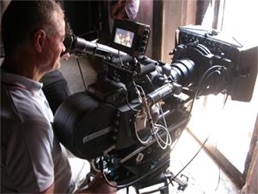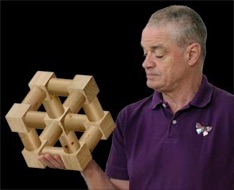


This site is written unashamedly in the first person. This reflects the fact that this is a very personal site.
I do not consider myself an artist ....... a creative artisan, certainly. I worked as a movie cameraman and thus my role was to give flesh and atmosphere to a director's vision. It is an interpretive role that requires sensitivity to needs other than my own and the ability to use my own creativity to add visual interest and mood. Some of my work here reflects this. It is for the most part very photographic. A few years ago I retired at seventy five after fifty four years of working with film.
An Englishman living in Brussels, Belgium, married to a Viennese, and having two multi-lingual sons, I view myself as a European. Between us our family speaks five languages. By reason of my work, I've had the good fortune to travel a huge portion of the world, both developed and remote. The son of a photographer, I was, by the age of eight, already taking photographs an starting to use a darkroom. A liberal school background that combined heavy emphasis on the arts, alongside the disciplines of advanced mathematics and engineering drawing, led to rather diverse abilities which, together with my background, came together naturally in professional photography.
I am completely self taught in computer graphics. Late in life, already well into my fifties, I discovered a photo editing software bundled with a scanner, started to play with it and was soon exploring other graphics applications. This has now become a passion equalled only by my lifetime passion for Asian and Oriental inspired cooking. My prime interest is the creation of photorealistic Escher like illusions combining photography and computer generated imagery. Many of these are published in illusion books worldwide in and can be found on the Web. I was already sixty when I created my first illusion.
A SHORT MOVIE OF ME AT WORK (2009)
This short movie of me at work was made for Belgian television by RTBF - La Une in 2009. In French only.
ONLY FOR THOSE FAMILIAR WITH COMPUTER GRAPHICS - SOME GENERAL INFORMATION ON HOW I WORK
For the most part I do all my own photography but library images are also used from time to time, and a very few images are constructed entirely from library images. There is often a large amount of hand ‘painting’ and construction involved as well.
For most of the photographic elements I used a Canon PowerShot Pro 1, an 8 Megapixel SLR camera with a 2/3” CCD and integral 7x Zoom (28- 200m 35mm film equivalent).More recently I have started using the 18 Megapixel Canon EOS 600D with two zooms 18-55mm and 55-250mm. This is a high end semi professional SLR. I also find the orientable viewfinder an absolute must.
For vector constructions I use mostly CorelDRAW. Most of my illusions start with a vector construction in classical vanishing point perspective or with an isometric projection. DRAW has an excellent toolset for perspective distortions and extrusions which I use to create my basic constructions.
I tend to avoid 3D, which I find a bit mechanical, and which is hard to use to create constructions which, by definition, cannot exist in 3D space. However I have recently developed ways of bending the incredibly quick and intuitive Trimble Sketchup to my particular needs. It has the ability to create a 3D camera by analysis of vanishing points in a 2D image. It is also great for ‘thinking aloud’ for ‘sketchpad’ testing of an idea. I also use Strata Design 3D CX for finished renders. Strata is designed quite specifically as a partner to Photoshop and has the ability to interface directly with Photoshop’s layers and to render directly to multiple Photoshop 2D layers and animation layers.
By far the lion’s share of the work here is done in Adobe Photoshop. and some is done in Serif Affinity Photo.TImages are first composited ‘flat’ without lighting. I then approach them exactly as I would an unlit film set, and add life and atmosphere by ‘lighting’ them. Although the physical techniques of lighting in the real world and lighting in Photoshop or Affinity are poles apart, the mental and visual approach is virtually identical.
I use an A4 Wacom Intuos pen tablet and a Razer Tartarus V2 keypad in the left hand mapped for modifiers and main program functions. (This is actually a device for gamers but it adapts perfectly to my particular needs in graphics). I try not to touch a keyboard except when entering text or naming layers. I find that the flow from mind to screen is more fluid and instinctive this way. I also use a 3D Connexion Space Navigator for 3D navigation.
To avoid the predictable digital look, I use almost no plugins or complex filters, preferring to work entirely by hand. My philosophy has always been that the subtlety and conviction of any Photoshop effect is likely to be inversely proportional to the number of knobs on it!
For many years I used a 2008 Mac Pro computer. Modern software incompatibilities means that this has now had to be replaced by a high spec 27 inch 5K iMac with tons of RAM and high end video card. When I need to run Windows software (Corel for example) I do so by means of a virtual PC on my Mac using VMWare Fusion. Aside from avoiding two machines, this also permits direct data transfer between the two operating systems running simultaneously.
CAMBIGUITIES is the official site of illusion creator David Macdonald. All images strictly copyright of the artist. Permissions Contact Cambiguities Site Map
